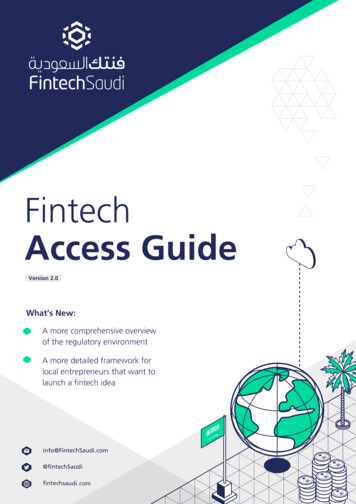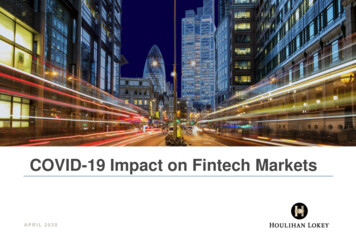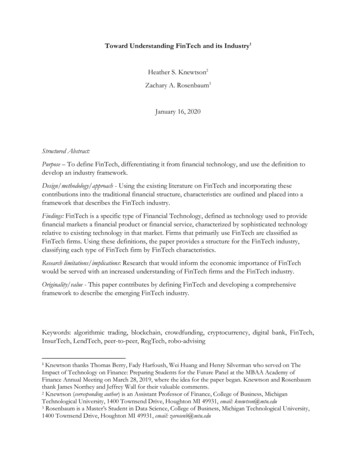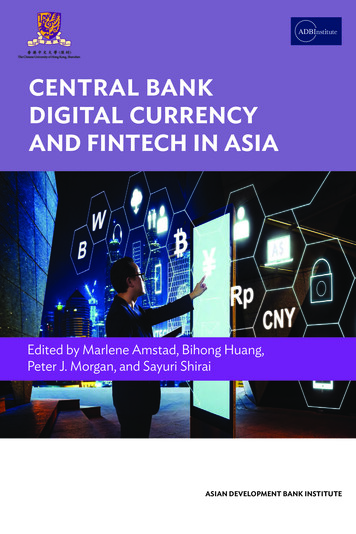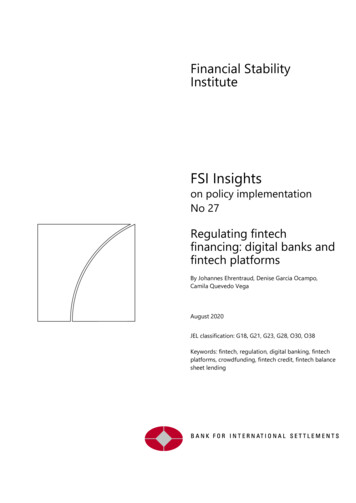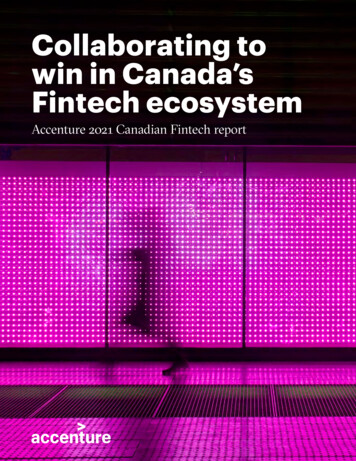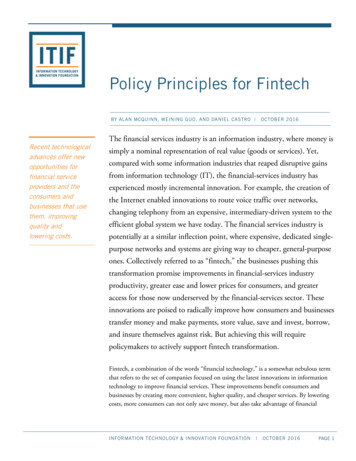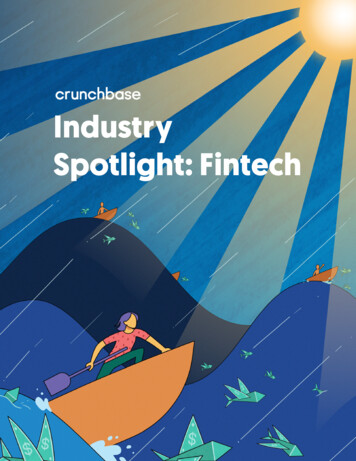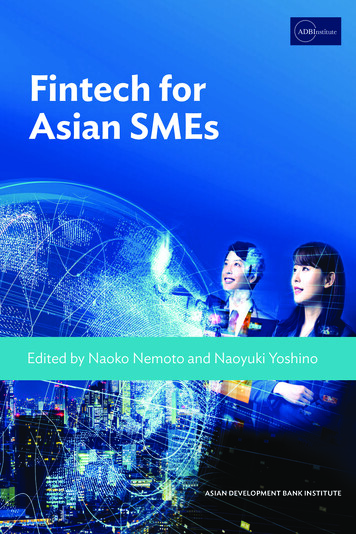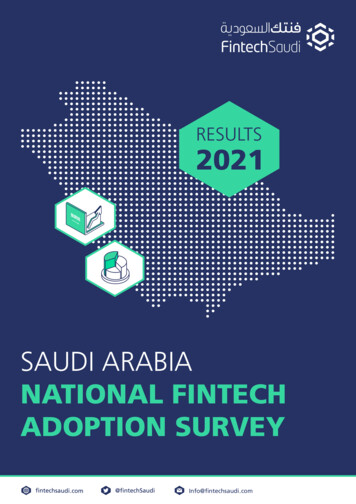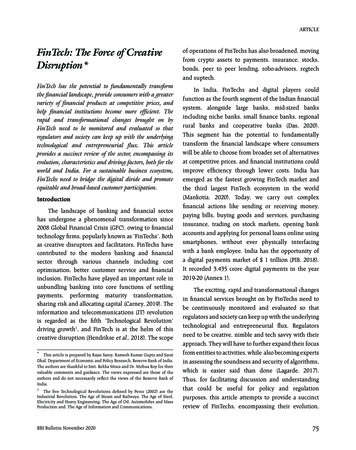
Transcription
FinTech: The Force of Creative DisruptionFinTech: The Force of CreativeDisruption*FinTech has the potential to fundamentally transformthe financial landscape, provide consumers with a greatervariety of financial products at competitive prices, andhelp financial institutions become more efficient. Therapid and transformational changes brought on byFinTech need to be monitored and evaluated so thatregulators and society can keep up with the underlyingtechnological and entrepreneurial flux. This articleprovides a succinct review of the sector, encompassing itsevolution, characteristics and driving factors, both for theworld and India. For a sustainable business ecosystem,FinTechs need to bridge the digital divide and promoteequitable and broad-based customer participation.IntroductionThe landscape of banking and financial sectorhas undergone a phenomenal transformation since2008 Global Financial Crisis (GFC), owing to financialtechnology firms, popularly known as ‘FinTechs’. Bothas creative disruptors and facilitators, FinTechs havecontributed to the modern banking and financialsector through various channels including costoptimisation, better customer service and financialinclusion. FinTechs have played an important role inunbundling banking into core functions of settlingpayments, performing maturity transformation,sharing risk and allocating capital (Carney, 2019). Theinformation and telecommunications (IT) revolutionis regarded as the fifth ‘Technological Revolution’driving growth1, and FinTech is at the helm of thiscreative disruption (Hendrikse et al., 2018). The scope*This article is prepared by Rajas Saroy, Ramesh Kumar Gupta and SaratDhal, Department of Economic and Policy Research, Reserve Bank of India.The authors are thankful to Smt. Rekha Misra and Dr. Mohua Roy for theirvaluable comments and guidance. The views expressed are those of theauthors and do not necessarily reflect the views of the Reserve Bank ofIndia.1The five Technological Revolutions defined by Perez (2002) are theIndustrial Revolution, The Age of Steam and Railways, The Age of Steel,Electricity and Heavy Engineering, The Age of Oil, Automobiles and MassProduction and, The Age of Information and Communications.RBI Bulletin November 2020ARTICLEof operations of FinTechs has also broadened, movingfrom crypto assets to payments, insurance, stocks,bonds, peer to peer lending, robo-advisors, regtechand suptech.In India, FinTechs and digital players couldfunction as the fourth segment of the Indian financialsystem, alongside large banks, mid-sized banksincluding niche banks, small finance banks, regionalrural banks and cooperative banks (Das, 2020).This segment has the potential to fundamentallytransform the financial landscape where consumerswill be able to choose from broader set of alternativesat competitive prices, and financial institutions couldimprove efficiency through lower costs. India hasemerged as the fastest growing FinTech market andthe third largest FinTech ecosystem in the world(Mankotia, 2020). Today, we carry out complexfinancial actions like sending or receiving money,paying bills, buying goods and services, purchasinginsurance, trading on stock markets, opening bankaccounts and applying for personal loans online usingsmartphones, without ever physically interfacingwith a bank employee. India has the opportunity ofa digital payments market of 1 trillion (PIB, 2018).It recorded 3,435 crore digital payments in the year2019-20 (Annex 1).The exciting, rapid and transformational changesin financial services brought on by FinTechs need tobe continuously monitored and evaluated so thatregulators and society can keep up with the underlyingtechnological and entrepreneurial flux. Regulatorsneed to be creative, nimble and tech savvy with theirapproach. They will have to further expand their focusfrom entities to activities, while also becoming expertsin assessing the soundness and security of algorithms,which is easier said than done (Lagarde, 2017).Thus, for facilitating discussion and understandingthat could be useful for policy and regulationpurposes, this article attempts to provide a succinctreview of FinTechs, encompassing their evolution,75
ARTICLEFinTech: The Force of Creative Disruptioncharacteristics and driving factors. Our evaluationthrows up sobering concerns regarding the future ofFinTechs, such as the status of digital hygiene, datause and privacy. The article proceeds in five sections:the FinTech revolution in the global context, delvinginto its history, evolution, and adoption in Section II,the FinTech ecosystem in India, its enablers, diversity,funding and collaboration with banks in Section III,challenges for future development in Section IV, andthe way forward in Section V.II. FinTech Revolution: The Global ContextDefinition of FinTechWith no universally agreed upon definition,FinTech is generally described as an industry thatuses technology to make financial systems and thedelivery of financial services more efficient. It is“technologically enabled financial innovation thatcould result in new business models, applications,processes or products with an associated materialeffect on financial markets and institutions andthe provision of financial services” (FSB, 2019).FinTechs are “start-ups and other companies that usetechnologies (Table 1) to conduct the fundamentalfunctions provided by financial services, impactinghow consumers store, save, borrow, invest, move, pay,and protect money” (McKinsey, 2016).In today’s app-centric world, consumers are lessconcerned about receiving all their services froma single provider, and instead expect a seamlessexperience. FinTechs are realising this new valueexpectation and have started to ‘unbundle’ many ofthe traditional financial offerings (Basole and Patel,2018). At the same time, the financial services providedby FinTechs are being re-bundled with a range of nonfinancial services, thereby allowing services to beprovided seamlessly via application software (Bankof Japan, 2018). Illustratively, taxi aggregators bundleride sharing with instantaneous fare payment uponarrival at destination.FinTech History and EvolutionTechnology-induced financial innovation has along history. In the 1950s, credit cards appeared forthe first time, followed by Automated Teller Machines(ATMs) in the 1960s, electronic stock trading andbanks’ new data recording systems in 1970s and1980s, and e-commerce and online brokering in1990s (Basole and Patel, 2018). The online revolutionin the last decade of the 20th century connected theworld through the Internet, and enabled e-commerce,Internet banking and pioneering online paymentplatforms like PayPal. The next decade witnessedthe emergence of smart technology. The smartphonematerialised as a powerful computer in humanTable 1 : Key Enabling Technologies used by FinTechsTechnologyDescriptionAPI (Application Programming Interface)APIs comprise a set of rules and specifications that software programmes use to communicate with eachother. They allow new applications to be built on top of others.Cloud ComputingThe use of an online network (‘cloud’) of hosting processors to increase the scale and flexibility of computingcapacity, generating cost savings.BiometricsThe study of distinctive and measurable human characteristics that can be used to categorize and identifyindividuals.DLT (Distributed Ledger Technology)A digital system for recording the transaction of assets in which details are recorded in multiple places atthe same time.Big DataVoluminous amounts of structured or unstructured data that can be generated, analysed and utilized bydigital tools and information systems.AI (Artificial Intelligence) & ML(Machine Learning)IT systems that can perform functions that would otherwise require human capabilities. ML entailscomputers learning from data without human intervention.76RBI Bulletin November 2020
ARTICLEFinTech: The Force of Creative Disruptionpalms, and the movement to app-based operatingsystems spurred innovation, unbundling and sharingof services. Bitcoin came as another importantdevelopment in 2009. The present decade is dedicatedto the ‘rise of the robots’, where the emergence ofbig and unconventional datasets has enabled AI toprovide accurate predictions and personalise banking(King, 2019).The ‘new’ FinTech sector gained momentumin its modern incarnation after the GFC as FinTechentrepreneurs realised that banking services shouldbe transparent, facilitative and economical (Hendrikseet al., 2018). After the GFC, public perception of bankshad deteriorated, as savings were diverted to subprimeborrowing without adequate consumer protection.Many finance professionals confronted job losses orpay cuts, which inspired enterprising innovation asFinTechs (Buckley et al., 2016). Also, tighter regulationof traditional banking after GFC supported the growthof the FinTech sector (Cortina et al., 2018).At present, FinTechs are diversifying intodifferent sectors (Chart 1). Among the top 100FinTechs, payment and lending companies are beingreplaced by wealth and brokerage, insurance andmulti-sector companies2 (KPMG, 2019).Demand-side Push to FinTech AdoptionAgainst the backdrop of globalisation anddigitisation, users’ appetite for financial services hasbecome increasingly diversified and sophisticated inline with their changing lifestyles. The rate of FinTechadoption is greater in jurisdictions where there isunmet demand for financial services, less competitionfrom traditional finance, macroeconomic conditionsare conducive, regulation is accommodative anddemographics are favourable (Frost, 2020). Accordingto the ‘Global FinTech Adoption Index 2019’, theadoption of FinTech services globally has progressedfrom 16 per cent in 2015 to 33 per cent in 2017 and64 per cent in 2019. Despite concerns about dataChart 1: Top 100 FinTechs by Business ModelsSource: FinTech 100, KPMG and H2 Ventures (2019)2Neo-banks have digital as the only or predominant channel for engaging with customers and challenge either the products, user experience or businessmodels of traditional banks and other financial services organisations; Multi-companies are FinTechs providing a diversified range of financial servicesproducts to customersRBI Bulletin November 202077
ARTICLEFinTech: The Force of Creative Disruptionsecurity, the respondents preferred FinTechs overthe traditional sector due to low fees and ease ofopening of accounts (EY, 2019).Supply-side Support to FinTechof 8 companies on the FinTech100, India is emergingas a prominent FinTech force3.Benefits of FinTechsEfficiency enhancementReflecting on growing adoption over the pastdecade, many start-ups have come up with diverseand innovative FinTech products. They have beensupported enthusiastically by investors, withinvestments in the sector increasing from 5 billionin 2010 to 78 billion in 2019 (Chart 2).Geographical Distribution of FinTechsA unique feature of FinTech has been its shiftinggeography; both in terms of the locus of activitiesand the area of influence. According to KPMG’sFinTech100, the new productive ground for FinTechcompanies is shifting from North America and Europeto the Asia-Pacific; 42 companies from the Asia-Pacificregion (highest among all regions) were featured in2019 as compared to 31 companies in 2017. Withinthe Asia-Pacific, China is facing stiff competition fromcountries like India, Vietnam and Korea. With a totalFinTechs have played a key role in making thefinancial sector more efficient (Philippon, 2020). Inthe USA, FinTech lenders enhanced ease of borrowingby processing mortgages 15-30 per cent quicker thanother lenders with no evidence of higher (conditional)default rates (Fuster et al., 2018).Financial on asymmetry or high transaction costs,FinTechs help enhance financial inclusion. In a surveyof retail borrowers on a large Chinese platform, morethan half reported that they had no prior borrowinghistory from a financial institution (Deer et al., 2015).Big data and machine learning techniques may evenhelp reduce human biases against discriminatedgroups (Bartlett et al., 2018).Chart 2: Global FinTech InvestmentSource: Tracxn Database, upto June 2020.3Paytm ranked fifth and OlaMoney ranked eighth.78RBI Bulletin November 2020
ARTICLEFinTech: The Force of Creative DisruptionReduced credit risksBy providing more choice of credit sources,proliferation of FinTechs could lower the risks aneconomy faces if credit provisioning is dominatedby a few banks. FinTechs focused on credit could bebeneficial for commercial banks as some of them relyon FinTech platforms’ credit assessment processes(Claessens et al., 2018).Chart 3: FinTech Tree Highlighting theRole of RegulationFinTech RegulationFintechs can be viewed as double edged swords.Despite various benefits, these innovations cansometimes magnify existing threats to consumerssuch as likelihood of privacy breaches andcybersecurity risks, leaving behind digitally illiterateand unconnected consumers. Thus, while the roleof regulation is undisputed for the financial systemas such, it assumes greater importance for newerinnovations such as FinTechs.A central bank’s interest in FinTech is not confinedto its impact on the financial sector per se, but ratherits implications for financial stability and monetarypolicy. The regulatory environment, like the roots thatprovide life to a tree, provides a solid foundation forFinTech activities (Chart 3).A survey-based study under the aegis of the Bankfor International Settlements (BIS) summarises theresponses of regulators across the world to rapidlyemerging FinTech (Ehrehtraud et al., 2020). Whilemost surveyed jurisdictions did not have a dedicatedregulatory regime for FinTech lending, many hadit in place for digital payments and crowdfunding.For insurance, existing regulations were broadlyconsidered sufficient. Warnings and clarificationswere the most common regulatory responses tocrypto-assets, but a few respondent jurisdictions alsoreported emergence of crypto-specific licenses. Withregards to enabling technologies, most regulatorstweaked existing guidelines to include tech-specificelements. Regulators have been particularly activeon application programming interfaces (APIs),cloud computing and biometric identification. WithRBI Bulletin November 2020Source: Financial Stability Institute, BIS (2020).many FinTechs leveraging on cloud computing, itis becoming systemically important to the financialsystem. It is possible that going forward some futuresoftware could end up being exclusively available oncloud platforms. In such cases, central banks may haveto opt for in-house cloud development or collaboratewith various service providers. For instance, the USFederal Reserve has visited Amazon’s cloud facilitiesfor on-site inspections, while the European BankingAuthority has published guidelines for cloudoutsourcing (King, 2019). However, for artificialintelligence, machine learning and DLT, regulatoryaction has been limited to risk assessments andissuance of general guidance.Financial regulators are facing unprecedentedchallenges with the emergence of FinTechs. Thesefirms come in new shapes and forms, so fitting theminto buckets for prudential or risk-based supervisionis not easy. As the scope of activities widens fromnational to global, regulation too has to reach outacross borders. Furthermore, if the importance of79
ARTICLEFinTech: The Force of Creative Disruptiontraditional banks in the financial system declines,central banks might have to increase the number ofcounterparties to their operations in money marketsfor effective monetary transmission (Lagarde, 2017).III. Evolution of the FinTech Ecosystem in IndiaThe roots of Indian FinTechs lie in thegroundwork done over the previous decade indeveloping key enablers. The Indian FinTech industryas it stands today is the result of a unique concoctionof technological enablers, regulatory interventionsand business opportunities as well as certain othercharacteristics unique to India.As the regulator of payment systems, the ReserveBank has undertaken numerous measures to ensureincreased efficiency and uninterrupted availability ofsecure, accessible and affordable payment systemsand to serve segments of the population which arehitherto untouched by the payment systems. Toachieve this, Reserve Bank’s Vision 2021 envisages fourgoal posts (4 Cs), i.e., Competition, Cost, Convenienceand Confidence.Regulatory EnvironmentIndia is one of the few jurisdictions with aspecific Payments and Settlements law to “providefor regulation and supervision of payments andsettlement systems in India and to designate theReserve Bank as the authority for the purpose and thematters connected therewith or incidental hitherto”.The Reserve Bank regulates some FinTechs directlyby granting them NBFC licenses (such as NBFC-P2P),or indirectly by regulating the banks and NBFCsassociated with them. National Payments Corporationof India (NPCI) is the umbrella organisation foroperating retail payments and settlement systemsin India, as an initiative of the Reserve Bank and theIndian Banks’ Association (IBA) under the provisionsof the Payment and Settlement Systems Act, 2007.The interventions in Payment and Settlement Systemproposed by the Reserve Bank in its various MonetaryPolicy Statements over the past year are presentedin Annex 2. A regulatory timeline depicting India’sfavorable policy moves to promote FinTech has beenillustrated in Chart 4.Chart 4: Regulatory Timeline of Indian FinTechNote: Vide its order dated March 04, 2020, Hon’ble Supreme Court of India set aside the RBI Circular on Prohibition on Dealing in Virtual Currencies on the ground ofproportionality.80RBI Bulletin November 2020
ARTICLEFinTech: The Force of Creative DisruptionMajor Enablers of Indian FinTechChart 5 : Wireless Data Usage and TariffPenetration of internet and smart phonesPropelled by massive strides in internet andsmartphone penetration, FinTechs have expandedtheir reach rapidly in India (Table 2).Favourable DemographyThe Indian market is blessed with a higherproportion of young population, who are more likelyto trust and adopt FinTech. There were 1157.75 millionwireless subscribers in the country as on March 31,2020, comprising 638 million urban and 519 millionrural subscribers (TRAI, 2020). India and China leadTable 2 : Telecommunications IndicatorsParameterTelephone SubscribersTeledensityInternet SubscribersBroadband SubscribersWireless Data UsagePeriodSource: Department of Telecommunications, Government of India (2020).Cumulativeamount31-Mar-14 to 30-Apr-2031-Mar-14 to 30-Apr-2031-Mar-14 to 31-Mar-2031-Mar-14 to 31-Mar-20Q3 2019-20Telecom Usage (Monthly Wireless 31-Mar-14 to 31-Dec-19Average Revenue per User)Telecom Towers01-Sep-17 to 27-Jul-20Gram Panchayats connected31-Aug-14 to 30-Jun-20under BharatNetTelecom Licenses31-Mar-14 to 30-Jun-20116.8 Crore86.6 %74.3 Crore68.7 Crore21,402Petabytes 78.76,05,7881,41,098156the Global FinTech Adoption Index 2019 with anadoption rate of 87 per cent. While per capita internetusage has increased, tariffs have declined (Chart 5).India StackIndia’s evolution as a progressive FinTech nationhappened on the back of the ‘India Stack’ – anindigenous set of technologies and policies that act asenablers to innovation (Chart 6)Source: Department of Telecommunications, Government of India (2020)Chart 6: Development of India StackSource: D’Silva et al. 2019.RBI Bulletin November 202081
ARTICLEFinTech: The Force of Creative DisruptionThe ‘India Stack’ encompasses two core principles- building digital platforms as public goods andincorporating data privacy and security in the design ofdigital public goods (D’Silva et al., 2019). An exampleof the India Stack for payment systems is shown inChart 7. The cornerstone of the India Stack is theAadhaar enabler, used to access a unique, verifiableidentity at low marginal cost by FinTechs. Over 1.25billion residents of India have been issued Aadhaar,and 30 million authentication requests are processeddaily (UIDAI, 2019). Various publicly providedplatforms for verification (e-KYC), digital signature(e-sign), cloud storage (DigiLocker) and paymentshave been developed over Aadhaar, which can be usedby innovators to create and exchange value, obviatingthe need to build their own digital infrastructure.Unified Payments Interface (UPI) is a pivotalenabler, which virtualises accounts and facilitatesData sharing frameworkWider access to data generated by online activitycould be beneficial since they are often obtained at zeromarginal cost and are non-rival4. Open access to datacould also lower switching costs for customers andgenerally foster competition and financial inclusion. In2016, the Reserve Bank established a legal frameworkfor a class of regulated data fiduciary entities, calledAccount Aggregators (NBFC-AA), enabling customerdata to be shared within the regulated financial systemwith the customer’s knowledge and consent. Accessto data will be granted to regulated entities (underthe RBI, SEBI, IRDA and PFRDA) for a limited timefor a specific purpose. Innovation facilitators are alsoimportant FInTech enablers. The Reserve Bank hasset up a ‘Regulatory Sandbox’ for issuing facilitativecustomers to undertake merchant payments and fundregulation to help the fast-developing FinTech sector,transfers.allowing live testing of new products in a controlledChart 7: India Stack for PaymentsSource: D’Silva et al. 2019.4A good is non-rival in nature when its consumption by one individual does not diminish the amount available for others.82RBI Bulletin November 2020
ARTICLEFinTech: The Force of Creative Disruptionregulatory environment to generate evidence on thebenefits and risks of financial innovations (RBI, 2019).The first cohort of applications considered for theRegulatory Sandbox was under the operational theme‘retail payments’ (RBI 2019a).Indian FinTechs: Strength in DiversityThe hallmark of India’s FinTech ecosystem isdiversity of markets and applications. It is seen thatemerging industries often concentrate regionally tobenefit from agglomeration effects, but FinTech doesnot follow this trend (Basole and Patel, 2018). Thoughconcentrated in major metropolitan cities such asMumbai, Bangalore, Delhi-NCR, and Hyderabad,FinTech is also expanding to smaller cities (Chart 8).Mumbai and Bangalore lead the FinTech momentumand account for 42 per cent of the startup headquarters.Other cities like Jaipur, Pune, and Ahmedabad are alsoemerging as centers of FinTechs (Medici & Pisabazaar:India FinTech Report 2019). According to the Tracxndatabase, there are a total of 4,680 companies in IndiaChart 8: FinTechs in India - GeographicalDistributionclassified as FinTechs, which can be grouped broadlyinto fifteen business models (Annex 3).Equity FundingStartups tend to raise money through equity,since they usually have no history of demonstratedearnings or collateral to offer to banks, which aregenerally conservative in lending. Lending to astartup requires assessment of novel parameters likethe future earnings potential of the unconventionalbusiness model, motivation and suitability of thefounders, business climate, domain knowledge, etc.Also, specialised equity investors like Venture Capitalfirms can be more ‘hands-on’ and guide startups tomake them more successful in the long run. Equityfunding also allows startups to take a long view oftheir business, since they are freed from immediateloan repayment obligations.According to Tracxn database, 211 Indian FinTechsraised 3.18 billion (in equity rounds and from angelinvestors) over 2019-20 (Chart 9). 25 FinTechs overand above these 211 also raised funding but did notprovide details. Fundraising activity took a hit inApril 2020 due to the spread of COVID-19 and theenforcement of a nationwide lockdown.LatitudeThe distribution of the funding of 3.18 billionraised during 2019-20 was highly skewed with thetop 10 companies (by equity funding) accountingfor approximately two-thirds of the total funding(Annex 4). Of this, 1 billion was raised by Paytmalone in November 2019. Most of the top FinTechfundraisers operate in the payments arena. Seed andSeries A, Series B and Series C funding5 constituted5LongitudeRBI Bulletin November 2020Start-ups tend to raise equity in successive pitches or rounds (Seed,Series A, B, C and so on), which broadly follow the growth/scale of thebusiness, and serve the needs of the business in that stage. Early roundsmay be used to establish a foothold in the market, while later rounds canbe used for expansion.83
ARTICLEFinTech: The Force of Creative DisruptionChart 9: Equity Funding of Indian FinTechsSource: Tracxn.14, 24 and 20 per cent of the equity pie respectively(Chart 10). Almost a third of the entire year’s FinTechfunding was obtained in the late Series G round byPaytm.FinTechs and Banks: CollaborationFinTech firms are no longer viewed by banks asdisruptive forces. There is evidence that FinTechsChart 10 : Funding by Round: 2019-20Source: Tracxn.84are acting as enablers in banking and finance. Banksare relying on a number of strategies to embracetechnological innovation; ranging from investing inFinTech companies and launching FinTech subsidiaries,to collaborating with FinTechs for various operationalfunctions. Banks and non-banks are partnering tooffer the combination of trust and innovation to theIndian consumer (Das, 2020). For enhancing revenuesand profits, they are diversifying into newer areassuch as insurance, asset management, brokerage andother services supported by financial technologies.There are synergies to be explored betweenFinTechs and banks. FinTechs, while possessingvast technological knowhow and new ideas, lack alarge client base and the expertise to navigate theregulations and licensing discipline of the financeindustry. Traditional banks possess a major strength- reputation for trustworthiness built over severaldecades. Banks have capital and can weather intensecompetition. They also have the benefit of experienceand tried-and-tested infrastructure alongside specificknowledge of risk management, local regulations andcompliance. In fact, banks’ on-the-ground market andRBI Bulletin November 2020
FinTech: The Force of Creative Disruptioncustomer knowledge and pre-existing client base canbe of immense value to FinTech projects. In a nutshell,banks and FinTech firms have different comparativeadvantages and a strategic collaborative partnershipbetween the two would liberate them to focus ontheir respective core competencies (Mundra, 2017).IV. Challenges for Future DevelopmentFinTechs will confront several opportunities andchallenges in the future. Broadly, they need to addresssix concerns to become more efficient, reliable,equitable and resilient.First, despite immense scope for innovation,cross-border payments are still unchartered territoryfor FinTechs. Availing remittance services burdensmigrant workers due to steep costs associated withsuch remittances (D’Silva et al,. 2019). A high share ofcross-border payments flows through correspondentbanks, whose dwindling numbers could result ineven higher costs and retrogression to informal,unregulated payment networks (Carstens, 2020). InIndia, cross-border transactions are slow comparedto domestic payments and few alternatives areavailable, despite heavy inward personal remittances(RBI, 2019). To make payment systems in differentjurisdictions interoperable, payment instructionsneed to be translated to a common language. For this,standards and practices across jurisdictions must becoordinated, and mutual confidence in each domesticnetwork’s Know Your Customer (KYC) and Anti-MoneyLaundering (AML) frameworks must be established.Recently, UPI was connected with Singapore’s Networkfor Electronic Transfers (NETS) on a pilot basis at theSingapore FinTech Festival 2019 (ET, 2019), suggestingthat significant advances could be made within theexisting setup. The UPI system settles in fiat moneywithin the regulated financial system perimeter andtherefore, poses less risk than systems such as stablecoins which are usually managed by BigTechs.RBI Bulletin November 2020ARTICLESecond, the increasing popularity of FinTechscould exacerbate data use, protection and privacyconcerns if the statutory rights and obligations ofservice providers are not clearly delineated. Machinelearning algorithms could reproduce and perpetuateexisting patterns of discrimination and excludevulnerable sections. As the Indian populationbecomes data-rich with increasing Internet andmobile coverage, the next challenge is empoweringconsumers with the data generated by them throughadequate legal and regulatory interventions. Citizensshould be able to exercise control of their data like anyother personal asset. There is an emerging demandfor data localisation from various jurisdictions. Inthis context, a solution could be a model where datais stored locally, and only binary (Yes or No) queriesare allowed on it from abroad, from a specified andglobally agreed upon set of permitted queries.Third, there is a need to ascertain the impact ofFinTech on financial stability, due to higher potentialfor system-wide risk with its expansion. Lendingstandards could weaken due to wider credit accessand higher competition. Since FinTech lenders giveadvances from debt and equity rather than fromdeposits, such credit could be more procyclical andvolatile due to lack of standard credit guidelines.Further, credit activity outside the prudentialregulation space could render credit-relatedcountercyclical policies less effective. Reputational,cyber and third-party risks may arise for banksinteracting with FinTechs.Fourth, there is inequality of access to FinTechservices. Despite having the world’s second largestInternet user base, the access to Internet is stillhighly biased towards the urban, male and affluentpopulation segments. Trust in the
Nov 11, 2020 · FinTech: The Force of Creative Disruption security, the respondents preferred FinTechs over the traditional sector due to low fees and ease of opening of accounts (EY, 2019). Supply-side Support to FinTech Reflecting on growing adoption over the past decade, many start-ups have come up with diverse and inn
